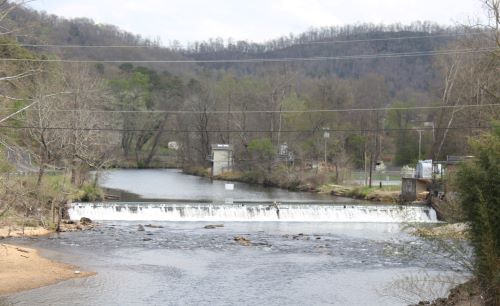Story originally published in The Sylva Herald, May 10 edition
Repair or remove … that’s the decision facing local leaders about the Cullowhee Dam, owned and operated by Western Carolina University.
WCU is waiting on an assessment and plan allowing consulting firm McGill & Associates to proceed in designing and bidding for repairs to the Cullowhee Dam. At the same time, they are considering a recommendation from conservation nonprofit American Rivers to remove the dam.

Cullowhee Dam will see some repairs to address ongoing erosion.
According to the timeline provided by WCU Vice Chancellor For Administration Finance Mike Byers, Mcgill & Associates will have the design and permit from the state construction office by the end of June. Officials hope by the end of August to have the bidding process done so repair of the dam can start. They are hoping this work to be finished by the end of August 2024.
WCU committed $900,000 for the project in 2019. Byers did not had an updated cost estimate during the interview but was sure it will cost more.
McGill Engineering began designing the necessary abutment repairs in August 2022.
The dam is located in the Tuckaseigee river, approximately 600 feet upstream of the Old Cullowhee Road/SR 1002 bridge. It is made of concrete, approximately 7 feet tall, and 160 feet long.
It was originally built in 1930 to generate hydroelectric power, but now serves to flood the wet wells of the raw water intakes for WCU and the Tuckaseigee Water and Sewer Authority.
The dam hasn’t had any major repairs since the initial construction, Byers said.
In a 2019 Cullowhee Dam study, American Rivers proposed fully removing of the dam, seeing it as the best solution for river flow and ecology. It would also provide enough intake water for the two water treatment plants owned by WCU and TWSA, their report said.
In the response to the report, as an appendix, WCU and TWSA argued that the study does not provide concrete evidence as to how removal of the dam would affect the water treatment plants.
“We currently collect water from behind the dam, and it’s treated at the nearby water plant,” Byers said. “We don’t have a clear answer from American Rivers or anyone for how dam removal could impact our current method.”
Another part of Byers hesitation comes from being a state employee, which often comes with risk aversion.
“I didn’t want to be the guy who tore down the dam if it risked jeopardizing WCU’s water source,” said Byers.
For now, WCU is proceeding with repair plans, which “should be done soon,” according to Byers.
“We will have minimum repairs to the abutment and other parts of the dam to prevent issues now or in the future, and if we are able to replace the water plant down the road, we will consider removing the dam entirely then,” said Byers.
A wrong decision could have significant impacts on campus access to drinking water. Luckily, it’s not an extremely urgent issue.
“The erosion damage has progressed, but not at a worrisome rate. The concern at some point, it could fail, preventing it from retaining the water we need,” said Byers.
Concerns about the dam go back a long way.
In 2004, following hurricanes Frances and Ivan, WCU asked engineers to evaluate the structural integrity of the dam.
The engineers warned WCU in 2004 about possible extensive damage. Among other problems, they noted a “severely undermined” abutment wall. A full dam inspection was recommended, before more flooding occurred.
McGill released its initial 140-page report on the dam in July 2017. The study found the dam had been undercut, creating a 3-foot wide, 1.5-foot opening underneath that could lead to structure failure. Additionally, erosion along one of the dam’s walls could trigger the slide of an overhead slope, destroying a portion of nearby Wayehutta Road.
That report offered seven courses of action, including doing nothing, repairing or removing the dam. It said that “no action” is not an option, as the dam is too fragile due to the undercut and other structural deficiencies.
The recommended course of action was Alternative 2.B, “to repair the dam and address safety and maintenance concerns … a preliminary opinion of total project cost, including design, permitting, contract administration, and construction management, of approximately $900,000.”The 2.B alternative would mean no changes for the intakes above the dam for WCU and TWSA, which serves Dillsboro, Webster, Sylva and Jackson County.



